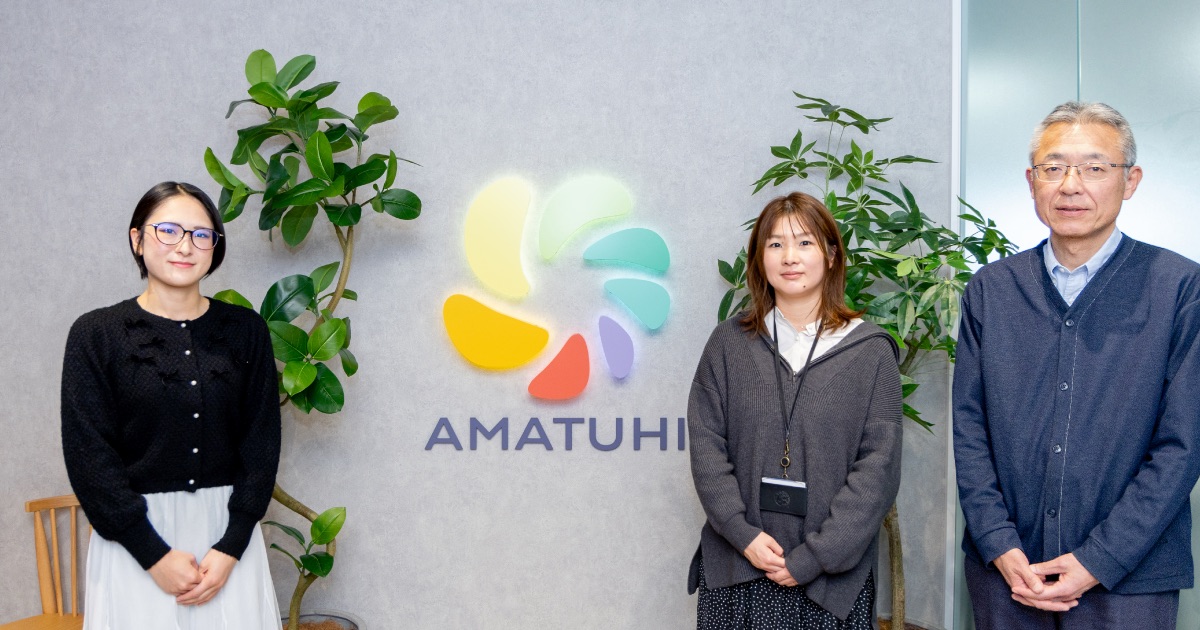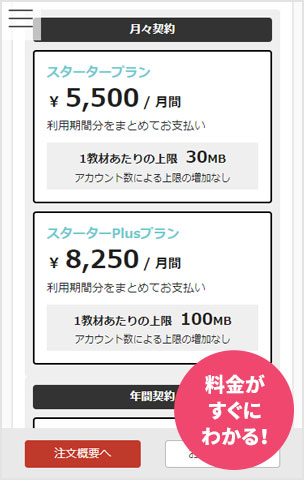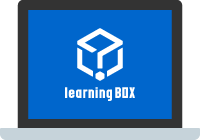LMS that enables training for all needs with fewer man-hours and helps develop study habits
Released on
Released on

(From left to right) Ms. Reima Higawa, Ms. Shoko Nakamura, Mr. Hidetoshi Sasaki

- Tried to use existing tools to test business understanding, but they were difficult to operate.
- Lack of resources for employee training and the need for efficient training implementation
- Wanted a simple system with only the necessary features, such as time limits


- New employee training programs have been launched by target group with the introduction of learningBOX, and results have been positive.
- One person is in charge of training and performance management for approximately 600 group home staff.
- Time limits, assignment of materials to each group, and other settings were simple and easy to operate, and we were also able to update training for other departments by introducing pre-existing business skills content.
AMATUHI Inc. was established by a representative who experienced physical aftereffects caused by mental disabilities. AMATUHI operates the "AMANEKU" group home for persons with disabilities, constructs group homes for persons with disabilities, and provides employment support services to help persons with disabilities participate in society and achieve self-fulfillment. LearningBOX is used to efficiently conduct training for employees who support residents and users. In addition, we have introduced and are using "KaWaL eLearning," a ready-made content that can be added to the LearningBOX. We interviewed the head office staff.
The training operation was strictly a combination of existing tools, and we had to look for a system
First of all, can you tell us about your company's business?
Mr. SasakiWe operate a group home for persons with disabilities under the brand name "AMANEKU. AMANEKU" is a "communal living assistance" service based on the "Comprehensive Support for Persons with Disabilities Act" that supports people who wish to live independently so that they can advance toward their respective goals through communal living in small groups and interaction with the local community.
AMATUHI has been in business for four years now and has more than 700 employees. The majority of them are on-site employees of the "AMANEKU" group home for people with disabilities.
Our group homes not only incorporate universal design, but also feature comfortable flow designs and stylish designs that incorporate the essence of art and greenery.
Mr. Higawa:One of the major characteristics of our company is that we are also developing a construction and real estate business specializing in group homes, providing a full range of support for daily living, from finding land to construction and subsequent management.

Mr. Nakamura.There are three major types of group homes (communal living assistance): "nursing care service inclusive type," "outside service use type," and "daytime service support type" (*1). AMANEKU mainly provides the Daytime Service Support Type, which was established in April 2018 as a result of amendments to the Comprehensive Support for Persons with Disabilities Act, and allows for the provision of extensive 24-hour services in response to the increasing severity and aging of people with disabilities.
AMANEKU daytime support group homes are mainly two-story buildings with a capacity of 10 residents on each floor, and are also equipped with care bathtubs (mechanical bathtubs) for those who have difficulty bathing on their own. There is a nationwide shortage of group homes for people with severe disabilities (*2), and each time we open a new one, we receive many inquiries from users about moving in.
(*1) Reference:
Ministry of Health, Labour and Welfare, "Remuneration and Standards for Communal Living Assistance"
(*2)
Ministry of Health, Labour and Welfare, "Overview of "Disability Support Categories" in the Act on Comprehensive Support for Persons with Disabilities"
Ministry of Health, Labour and Welfare, "Remuneration and Standards for Comprehensive Support for Persons with Severe Disabilities"
Can you tell us about your business?
Mr. Higawa:I am in charge of public relations in the Growth Strategy Department.
Mr. Nakamura.I am in charge of training for group home staff, including statutory training, and manual development in the Growth Strategies Department. I also manage training for the construction department and head office staff.
Mr. SasakiI concurrently serve in both the Growth Strategy Section and the General Affairs Section. In the Growth Strategy Section, I am responsible for the management of three section members.
Please tell us about the background of your need for an LMS (Learning Management System).
Mr. Nakamura.We wanted to implement a test to check the level of understanding of the group home's operations. Although social services have many sensory elements that are very difficult to quantify concretely, we thought that if we set a level of achievement and completed training to that level, we would be able to ensure a certain level of service quality. To this end, we set KPIs (Key Performance Indicators) such as the rate of test participation and the rate of trainer (supervisor) assignments.
We initially tried to use a combination of tools we were already using, such as Google Forms, to administer the comprehension tests, but there were issues such as the inability to limit the time and the use of English notation, so we considered implementing an LMS.
Since the concept for the test was already in place, we were simultaneously searching for a system and creating questions. We searched for a tool that would allow us to manage the certification test and contacted about three companies.
Simple, low-cost, and complete with necessary functions, enabling one person to manage approximately 600 people.
How did you become interested in learningBOX and what made you decide to introduce it?
Mr. Nakamura.One of the three companies we contacted was learningBOX. The ability to set time limits and low administrative effort were attractive features. The other two companies had too many features that were unnecessary, and their costs were very different from what we wanted.
learningBOX is a simple, low-cost solution that allows for time limits and (The list of options), materials can be assigned to each target group ("Assign ContentThe fact that the system has a "one-stop shop" function was also a deciding factor in our decision to introduce the system.
Did you encounter any difficulties from the introduction of learningBOX to the start of its operation? Please let us know if there are any points that are easy to use, or if there are any points that you would like to see improved.
Mr. Nakamura.It can be used to assign content or to create a "Access periodIt took a little time to define the first steps, such as setting up the "I'm a member of the team". However, once it was set up, it was easy to use, and even with a limited number of staff to perform administrative tasks, we are able to use the system without any major burden.
Mr. SasakiNakamura mainly handles the management of the learningBOX by himself, but he is happy to have introduced the LMS because he is able to smoothly manage the approximately 600 group home staff members.
Mr. Nakamura.Although our staff is older, even people in their 70s have taken the test without problems, and we feel that learningBOX is easy to use for everyone. As a request, we feel that an app version of learningBOX would be more convenient.
In addition, since we use LINE WORKS, the business version of LINE, to communicate with our staff, it would be very helpful if it could be linked to learningBOX. Currently, notices distributed via learningBOX are delivered by e-mail, but some staff members do not check their e-mail frequently, so we believe that the confirmation rate will be improved if notifications are delivered via LINE.

How are you actually using learningBOX? Please tell us about your management system and content.
Mr. SasakiA total of seven people, including ourselves and a representative, plan the employee training programs. The group home management staff is also included in this group, and we consult with them on the content of training programs for on-site staff. Employee training is mainly for group home staff, construction department staff, and head office staff.
Mr. Nakamura.In order to adjust the level of difficulty and support gradual growth, the training for group home staff is designed to be taken at one-month, three-month, and six-month milestones from the start of employment. The course duration is determined, and participants are required to complete the course within that time frame.
In the first month, to help them understand the basics of the business, they are given the opportunity to "learn the basics of the business".True/falseThe questions will be "0x" (zero/x questions).
The third month asks about terms and meanings related to the business.multiple-choice questionThe questions will be given to deepen the understanding of the students.
The sixth month focuses on the perspective of being able to convey the work to new employees as a trainer. Participants take a confirmation test after viewing manuals and video materials. For example, they are tested on their understanding of the AMATUHI concept and whether or not they are able to communicate the key points of cooking.
In addition, group home staff members receive monthly training to update their knowledge. Since they are also required to attend statutory training, we have developed a yearly schedule whereby half of the year's training is conducted in the form of statutory training.
What initiatives are you taking to increase training attendance? Also, have you seen any changes in your staff since you started the training?
Mr. Nakamura.The learningBOX "Manage notificationsWe use the "Training Course" system to send out notices three times during the course period. We have a system in place to share the status of each staff member's participation in the training with group home directors and supervisors (supervisors) so that they can follow up on the progress of each staff member.
In the course of the training, there were occasions when we realized that even long-serving staff members had surprisingly not correctly understood the nature of their work.
From the third month of training, more and more staff members are unable to pass the test, but a culture of self-learning is gradually taking root, with staff members reviewing the manual when they fail to pass the test.
Mr. SasakiWe are currently discussing the possibility of tying training performance to personnel evaluations, and it is a very significant change to have a culture of training and learning permeate the company, such as by setting the participation rate as a KPI. We will continue to improve employee training in order to prevent the specialization and standardization of work.
Mr. Nakamura.We have a certain number of staff members who are not qualified, but we hope that they will gain confidence by completing the training. Learning to provide good service is a matter of course, but I also tell our staff to "make self-study a habit" because it will lead to their own evaluation.
Are there any challenges in managing employee training?
Mr. SasakiThe test was called " Report assignmentEarlier, I mentioned that it would reduce the man-hours required for scoring on the administrator's side, "AI Report Analysis / AI Scoringand "Report assignments can be graded by setting scores from different perspectives.RubricsI am hopeful that the style of training will evolve in the future as we learn more about "the
Mr. Nakamura.Legal training is currently paper-based, but we would like to consider using learningBOX in the future.
Significantly reduce man-hours required for employee training by utilizing pre-existing content
How has the introduction of learningBOX been effective?
Mr. Nakamura.We have several group home sites, mainly in the Kanto area, and at the site with the highest participation rate, the grasp rate of operations has reached 80%. Our goal is to achieve a 100% understanding rate even with staff turnover in the future.
When we conducted a survey regarding training, we reflected one staff member's opinion in the training content, and he was very pleased. We have also seen an increase in positive comments such as "I am looking forward to next month's training" and "I am glad I got into the habit of learning," and we feel that the awareness of learning is increasing.

You have introduced "KaWaL eLearning," which specializes in business skills, through "learningBOX ON," a service that allows you to add a variety of employee training content to the learningBOX.
Mr. Nakamura.During the learningBOX review phase, content can be added to the "LearningBOXlearningBOX ONI had just learned of the existence of "The We introduced this system because of the campaign for the "I'm a fan of the new system". We are utilizing this system at the head office. Initially, we were using the manual creation and sharing system to review the manuals before taking the comprehension test.
Based on the idea that it is important to provide an opportunity to learn even once a month, we started training in earnest and have continued to do so for more than a year, especially in the construction department. At first, "KaWaL eLearning" was utilized only by the construction division, but due to requests from other divisions, the number of users has been increased. Currently, a training style that combines video viewing and confirmation tests using "KaWaL eLearning" is taking root throughout the entire head office.
What are the advantages of "KaWaL eLearning" and any requests for improvement?
Mr. Nakamura.We can develop training programs by simply selecting courses to be delivered by theme from the existing content and assigning them to each staff member, which is very helpful and requires fewer man-hours. It is easy to select courses for new employees, managers, etc., and the content is well thought out. At the time of introduction, we were told that the quantity of content itself might be a bit small, but we chose the content over the number of courses. We have no problem with this, as we select and distribute one piece of content per month.
As our company has been in business for four years and is still in the process of creating the framework itself, it is difficult to conduct group training, and KaWaL eLearning, which can be taken in one's spare time, is easy to use.
Mr. SasakiStaff members have commented that the videos are dramatized, so they do not get bored. Others say that the tests are difficult. I am confused by the fact that the questions are shuffled each time in the test, or that there is only one correct answer even though it says "select all". I think it is really well thought out and working hard is the best way to acquire knowledge.
Mr. Nakamura.As for requests for improvement, as I mentioned earlier, many staff members are not in the habit of checking their e-mail, so it would be very helpful if they could receive notifications on line.
I will consider this internally. How would you rate the attendance rate of "KaWaL eLearning"?
Mr. Nakamura.In November 2024, 28 out of 40 students have progressed to pass the confirmation test. 28 out of 38 students passed the test in October. The training program is becoming more and more established, and all staff members are taking it very seriously.
What is your vision for the future?
Mr. SasakiKaWaL eLearning" is currently being deployed uniformly as basic education, regardless of position. From the next fiscal year onward, we would like to select and develop training content by job level.
Mr. Nakamura.The training is conducted in a flexible manner, allowing participants to take the course at any time during their workday. We have seen an increase in the number of participants who are positively engaged in self-learning, inspired by seeing other staff and employees engaged in training and saying, "I'll do it, too. In our surveys, some have expressed a desire for group training, but this is a difficult aspect of the current situation in our fourth year.
Especially for management-level staff, there is a current situation in which operations are partly based on a person's past experience and personal competence. In the future, we would like to expand the scope of training in line with the growth of the company, so that we can standardize the work of the employees.
Thank you for your participation
.







